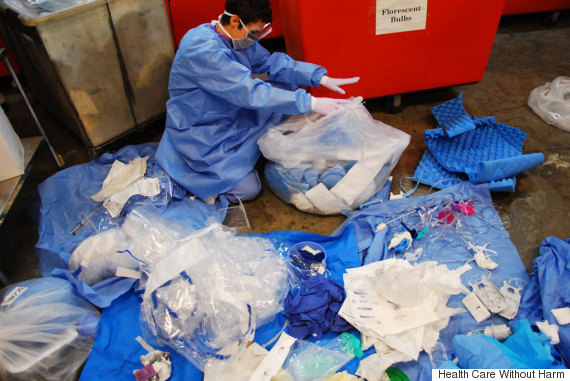A Greener Operating Room

As your stretcher is wheeled into a hospital operating room (OR) and you stare up at the bright surgical lights, you are likely thinking about your impending surgery, not if those lights have LED bulbs or if the anesthetic gas you are about to breathe contributes to climate change. But maybe you should be. Hospitals consume over 10% of the nation's energy and generate more than 5.9 million tons of waste a year, and the health care sector is responsible for 8% of U.S. greenhouse gas emissions. The OR consumes more than its fair share of resources, eating up, on average, one third of a hospital's supply costs, consuming a considerable amount of energy, and producing 20-30% of a hospital's total waste.
Despite the Hippocratic Oath to "First, do no harm," the way in which hospitals operate today can negatively impact the health of patients, staff, the community, and the environment. The burning of fossil fuels and the pollution of our air and water have been shown to have direct ties to an increase in asthma and allergies, certain types of cancers, immune-mediated diseases, and endocrine dysfunction. As hospitals increasingly recognize the fundamental connection between environmental and human health, there is no better place to start reducing our impact than in the OR where a disproportionate amount of resources are used, so even small changes can produce significant results.
The good news is that hospitals nationwide are transforming their surgical suites through environmental innovation. Their work spans everything from waste minimization and recycling, to environmentally preferable purchasing, to energy and water conservation, to better management of anesthetic gases.

Conducting a waste audit at Magee Women's Hospital of UPMC
Wow, there's a lot of stuff in here. To minimize waste, hospitals are taking a comprehensive look at the products they use, from purchasing practices to end-of-life disposal. Many hospitals are sterilizing instruments in hard cases rather than wrapping instrument sets in disposable plastic wrap. Hospitals are performing audits to remove unnecessary items from surgical kits that might otherwise be thrown away. Hospitals have switched to reusable fluid management systems and sharps containers, and are looking for products with less, more recyclable, packaging. And for the waste that is being generated, more and more clean material is able to be recycled -- plastic containers and plastic film and wrap, and even surgical instruments.
With patient safety in mind, hospitals have been using more single-use disposable items, but unfortunately this leads to increased waste and cost. A new industry,single-use device reprocessing, has developed in response to this trend. Instead of throwing out or recycling a single-use device, many of these medical devices can be "reprocessed" by a third-party reprocessor and bought back by the hospital at almost 50% the original price. This process is stringently regulated, and each device is cleaned, sterilized, and function tested -- so they can be safely used again. It has been estimated that if just 1 or 2% of all the disposable medical devices used in the US were reprocessed, the healthcare industry could save a billion dollars every year -- money that could be better used for patient care, research, bringing new treatments to the bedside, and making healthcare more affordable.
Boy is it cold in here! ORs consume a lot of energy when they are in use. Think about all of those machines, monitoring equipment, and lights. The rooms have strict code requirements when patients are in the room and need to be kept cold, be well lit, and must be set for a high number of air exchanges. A switch to LED bulbs (remember those bright surgical lights?) not only saves energy from the bulbs themselves, but because LEDs generate less heat, energy is also saved in cooling because the temperature in the OR can be set higher. And as an added bonus, you, the patient, won't be as cold lying there on the table.
For years, many hospitals kept the operating rooms running at full capacity -- lights on, high air exchange rates and low temperature - even when they weren't being used for patients. It doesn't make much sense to leave all the lights on in your house when you're at work or sleeping, does it? So in recent years, to prevent wasting energy when the OR is not in use, many hospitals have installed occupancy sensors and automatic setbacks so the high air exchange rates and low temperatures don't have to be maintained 24/7.
"10, 9, 8, 7 . . ." Many anesthesiologists ask you to count back from ten as they start administering anesthetics. Anesthetic agents -- desflurane, sevoflurane, isoflurance and nitrous oxide - are all global warming gases and contribute to climate change. Hospitals are working to reduce their use of desflurane, the gas with the highest global warming potential (which also happens to be the most expensive), and to adjust flow rates to minimize waste gases. Higher fresh gas flow rates are only needed to put you under anesthesia, not to keep you anesthetized. That extra gas doesn't get fully metabolized and instead is just exhaled as waste anesthetic gas. Currently, most hospitals capture waste gases and vent them to the outside (so the medical staff doesn't become anesthetized along with you or get sick from regular exposure), but there are newer technologies under study that capture anesthetic gases for reuse, rather than releasing them into the atmosphere.
Hopefully, you will not be wheeled into an OR any time in the near future, but as health care providers strive to eliminate practices that harm people and the environment, and new technologies become available, you might notice the OR looking a little more "green." That's good for you as a patient, good for hospital staff and good for our communities.
If you are interested in learning more about greening the OR, check out Practice Greenhealth, a nonprofit membership organization helping the healthcare sector adopt sustainable practices or its sister organization, Health Care Without Harm, an international coalition working to create a healthcare sector that promotes the health of people and the environment.
Join Practice Greenhealth
Practice Greenhealth is the health care sector’s go-to source for information, tools, data, resources, and expert technical support on sustainability initiatives that help hospitals and health systems meet their health, financial, and community goals.
